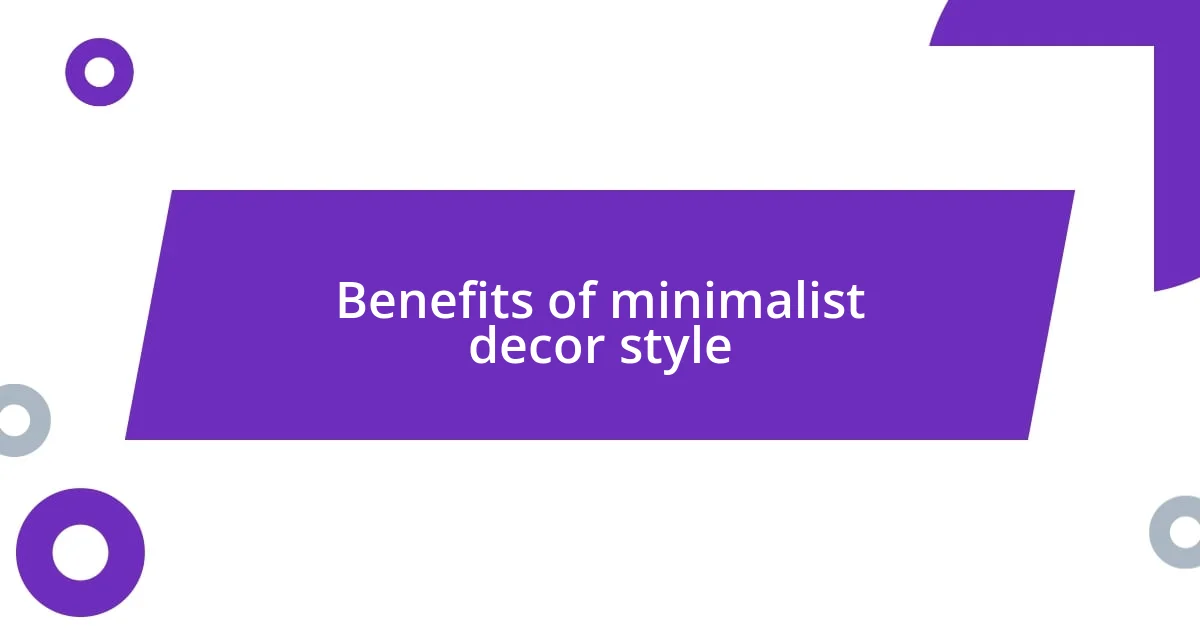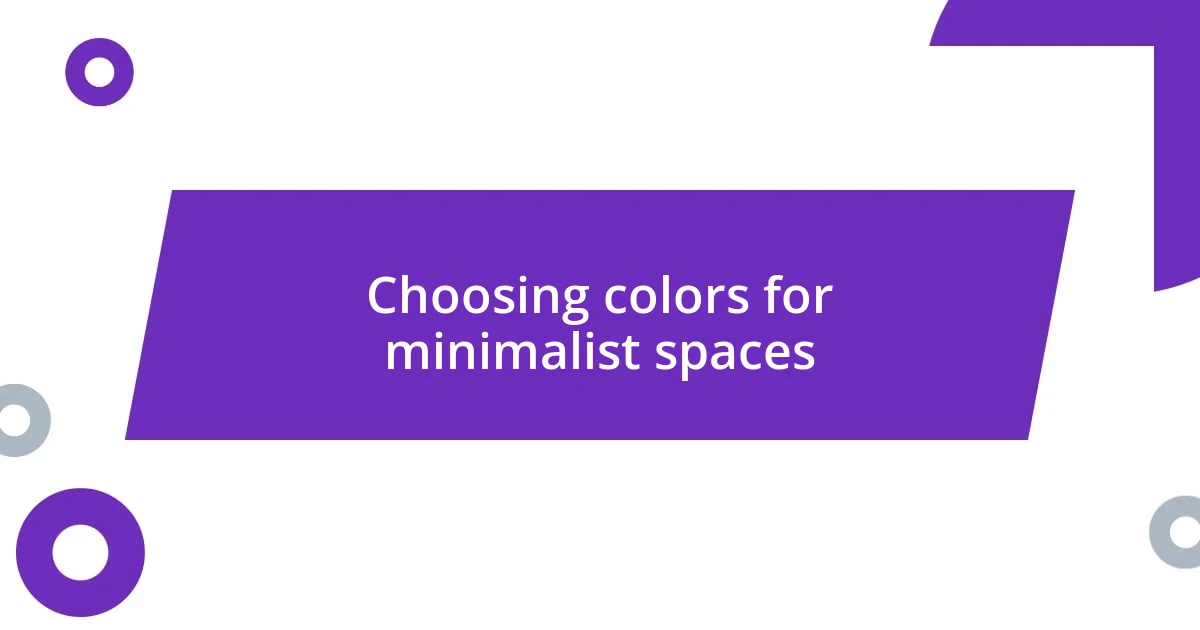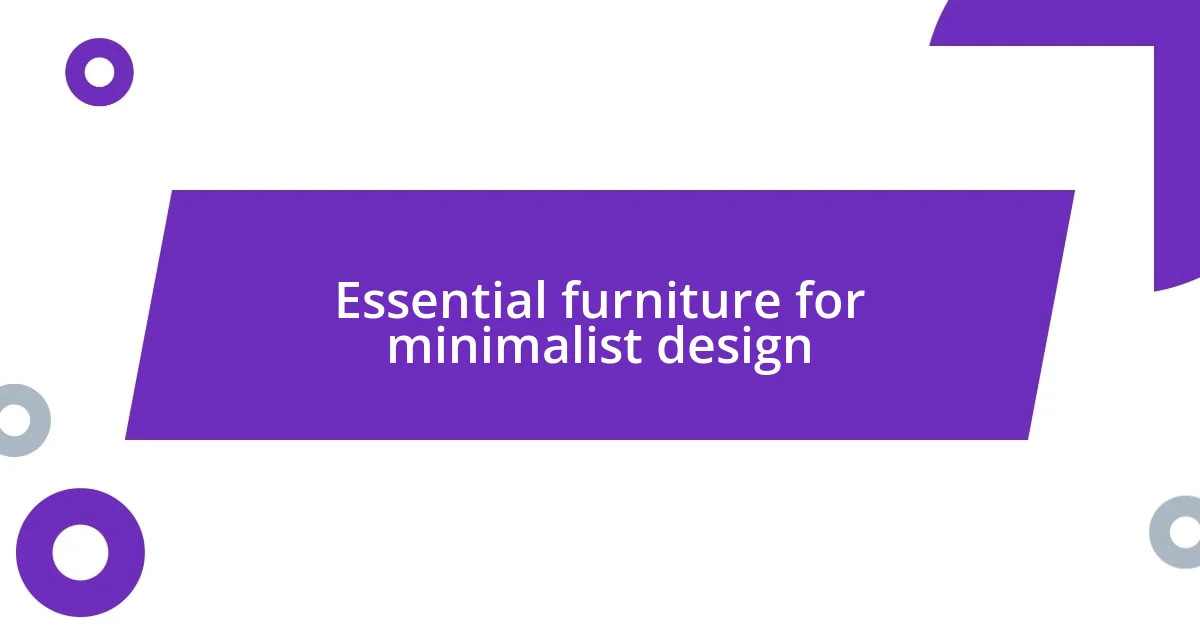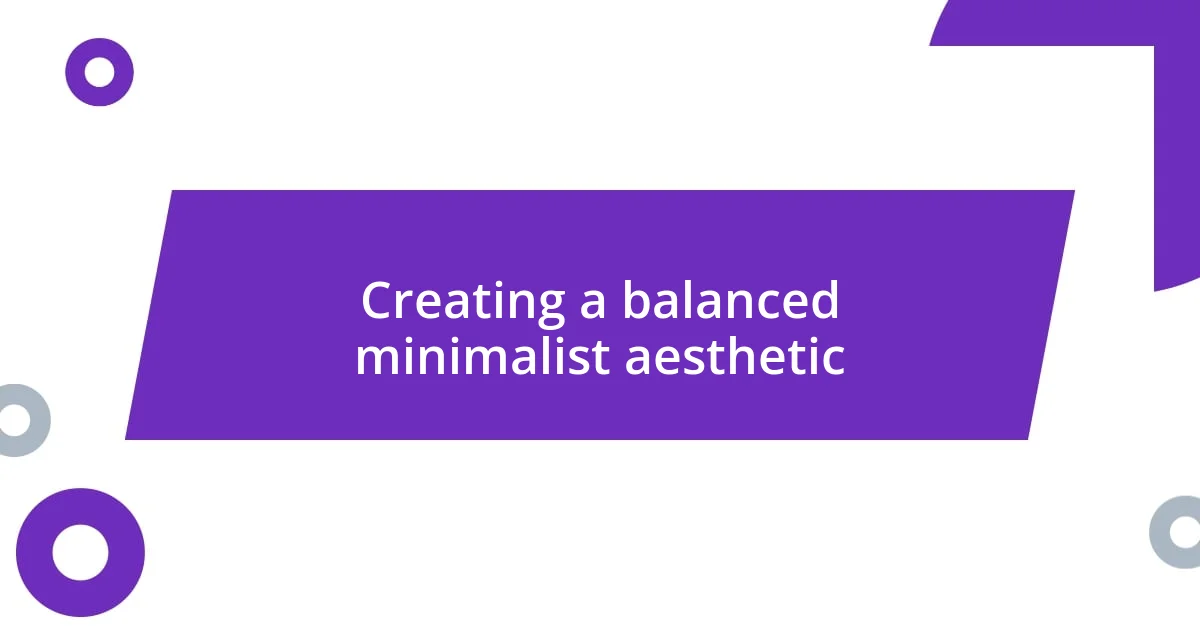Key takeaways:
- Embrace simplicity and functionality in decor by prioritizing quality over quantity and using neutral colors for a calming atmosphere.
- Adopting a minimalist style reduces stress, enhances focus, and promotes mindfulness, encouraging a decluttered and intentional lifestyle.
- Incorporating natural elements and creating intentional negative space can elevate minimalist design, fostering warmth and visual interest in your home.

Understanding minimalist decor principles
Minimalist decor is all about embracing simplicity and functionality. I remember when I first attempted to declutter my space; it felt liberating to let go of items I held onto for sentimental reasons. How often do we realize that less truly can be more?
One key principle is the idea of choosing quality over quantity. I’ve invested in a few timeless pieces that not only serve a purpose but also enhance my living space. It’s fascinating how a single well-crafted chair can become a statement in an otherwise sparse room. Have you ever noticed how the right piece can change the entire vibe of a space?
Another fundamental aspect is the use of neutral colors and natural materials. When I painted my walls a soft white, I was amazed at how light and airy my home felt. It’s as if the space opened up, inviting a sense of tranquility. Have you considered how color affects your mood? Understanding these detailed principles can help anyone create a harmonious atmosphere that feels authentic and inviting.

Benefits of minimalist decor style
Adopting a minimalist decor style offers numerous benefits that can transform the way you experience your living space. For me, one of the most striking advantages is the significant reduction in stress. I once replaced cluttered shelves filled with knickknacks with a few carefully chosen decorative items. This shift made a remarkable difference; walking into my home now feels like a breath of fresh air instead of a chaotic whirlwind.
- Enhanced focus: A simpler environment allows for clearer thinking and better concentration.
- Easier maintenance: With fewer items to clean and organize, chores become quick and straightforward.
- Increased creativity: Minimalism provides a blank canvas, enabling your ideas to shine without distraction.
- Emotional clarity: Surrounding yourself with only what you love fosters a sense of peace and contentment.
Embracing a minimalist approach also encourages mindfulness in every area of your life. I learned this firsthand when selecting decor became a deliberate process. Every decision was a reflection of my values, leading to a more intentional lifestyle. It was liberating to consider what truly brought me joy rather than simply filling my space with possessions.

Choosing colors for minimalist spaces
Choosing colors for minimalist spaces requires a thoughtful approach that harmonizes simplicity with emotional connection. In my experience, soft neutral tones like whites, grays, and beiges create a calming atmosphere that encourages relaxation. I remember selecting a muted gray for my living room walls; not only did it brighten the space, but it also made my vibrant artwork pop! Have you noticed how a well-chosen color can transform the emotional vibe of a room?
In minimalist design, sometimes less truly is more, particularly with color. I’m a fan of using one or two accent colors to maintain a clean look while still adding character. For instance, I painted just one wall a soft sage green, which introduced a refreshing element without overwhelming the space. This approach creates visual interest while adhering to the minimalist guideline of simplicity. Have you thought about how a single color can change the personality of a space?
Let’s not forget about how color affects our moods and energy levels. For me, bright whites and soft pastels evoke a sense of peace, while deeper hues can bring warmth and focus. I learned this years ago when I chose a striking navy blue for a study nook – it turned out to be both grounding and invigorating. What colors resonate with you, and how do they influence your daily life in your own space?
| Color Palette | Description |
|---|---|
| Neutral Tones | Promote calmness and spaciousness, ideal for a minimalist touch. |
| Accent Colors | Add personality and interest without cluttering the space. |
| Pastels | Soft and inviting, they enhance tranquility and warmth. |
| Bold Colors | Can energize a room, but should be used sparingly in minimalist design. |

Essential furniture for minimalist design
When it comes to essential furniture for minimalist design, the foundation often starts with multifunctional pieces. A simple yet versatile sofa bed has completely transformed my guest room. It serves as both a cozy lounge during the day and an inviting bed at night. Have you ever thought how one piece of furniture could serve multiple purposes while keeping your space uncluttered?
In my opinion, a sleek dining table with clean lines is another must-have. I chose a round table that can comfortably seat friends without imposing on the room’s overall flow. This choice not only facilitates conversation but also maintains an airy feeling in my open-concept space. It’s fascinating how a well-selected table can become the heart of your home while still adhering to minimalist principles.
Moreover, a minimalist design benefits from the presence of a statement piece, like an elegant armchair. I remember seeking out a chair that not only defined the area but also invited relaxation. Investing in quality over quantity has paid off; that chair has become my go-to for reading and reflection. Have you experienced how a single, thoughtfully chosen piece can elevate the entire ambiance of a room?

Incorporating natural elements in decor
Incorporating natural elements in decor brings warmth and authenticity to minimalist spaces. I love the idea of using simple wooden accents, like a reclaimed wood coffee table, which not only adds texture but tells a story of its own. Have you ever noticed how a single piece of natural wood can make a room feel more grounded and inviting?
Plants are another fantastic way to enhance a minimalist aesthetic while connecting with nature. I placed a low-maintenance snake plant in my living room, and its lush green leaves breathe life into the space. It’s remarkable how something as simple as greenery can uplift our mood and purify the air—what’s your go-to plant for adding a touch of nature indoors?
Natural textiles, such as linen or cotton, can also play a vital role in minimalist decor. I recently swapped out synthetic throw pillows for linen ones, and the difference has been incredible—not only do they feel softer, but they also add a visual layer of comfort to my space. How do you choose fabrics that reflect not just minimalism but also the soothing essence of nature?

Tips for decluttering and organizing
Decluttering can feel overwhelming, but I’ve found that starting small makes a huge difference. When I began tackling my space, I focused on one area each weekend—like my bookshelf or kitchen counter. This approach prevented me from feeling stressed, and I discovered the joy of clearing out things I hadn’t touched in years. Have you found a particular strategy that keeps you motivated during a decluttering session?
To keep everything organized, I implemented the “one in, one out” rule, which has become my personal mantra. Every time I buy something new, I make it a point to let go of an old item. This practice not only reduces clutter but also helps me appreciate the things I genuinely cherish. How do you decide what stays and what goes in your space—do you have any go-to questions you ask yourself?
Labeling is another essential tip that has transformed how I maintain order at home. I started using clear containers and labeled them according to their contents, which has made finding items so much easier. Last week, I even rediscovered a few treasures that had been buried in chaos! Have you ever found that a simple label can save you time and sanity while enhancing the minimalist vibe?

Creating a balanced minimalist aesthetic
Creating a balanced minimalist aesthetic really hinges on a thoughtful approach to space and design. I remember when I first started embracing minimalism; I found joy in arranging my furniture in a way that encouraged flow rather than clutter. Have you experimented with different layouts to see how it can transform the energy of your space? It’s incredible how even shifting a chair a few inches can change the vibe of an entire room.
Paying attention to color palettes is also vital. I used to be drawn to vibrant colors, but now I gravitate towards soft, neutral tones that create a calming environment. Recently, I painted my living room walls a gentle sage green, and it instantly made the space feel airy and serene. What’s your experience with color in your home? I believe the shades we choose can profoundly affect our mood and the overall feel of our sanctuary.
Finally, embracing negative space can truly elevate your decor. I used to fill every nook and cranny, but I’ve learned that allowing empty space to breathe can enhance the beauty of what remains. I had a beautiful vase that got lost among too many knick-knacks, but when I cleared the clutter, it took center stage and became a conversation piece. Have you tried creating intentional gaps in your decor? Balancing occupied space with negative space offers harmony and invites the eye to focus on what truly matters.














